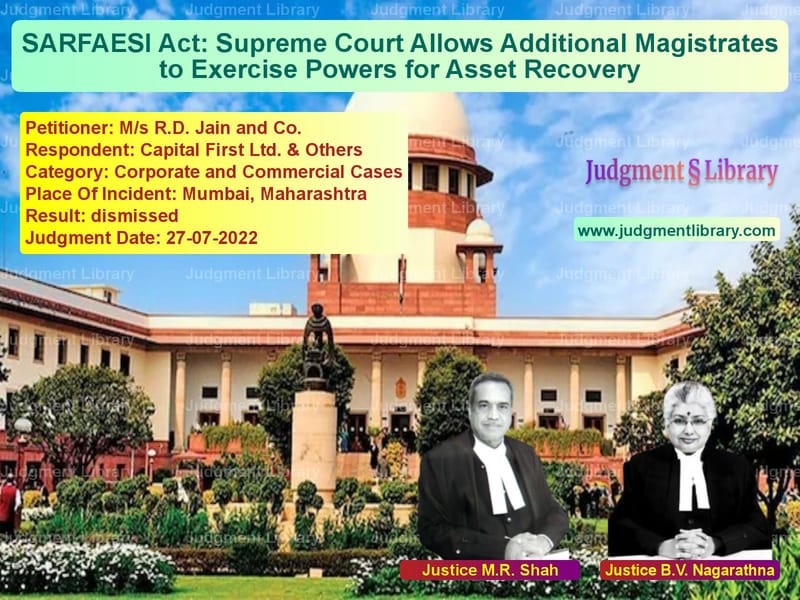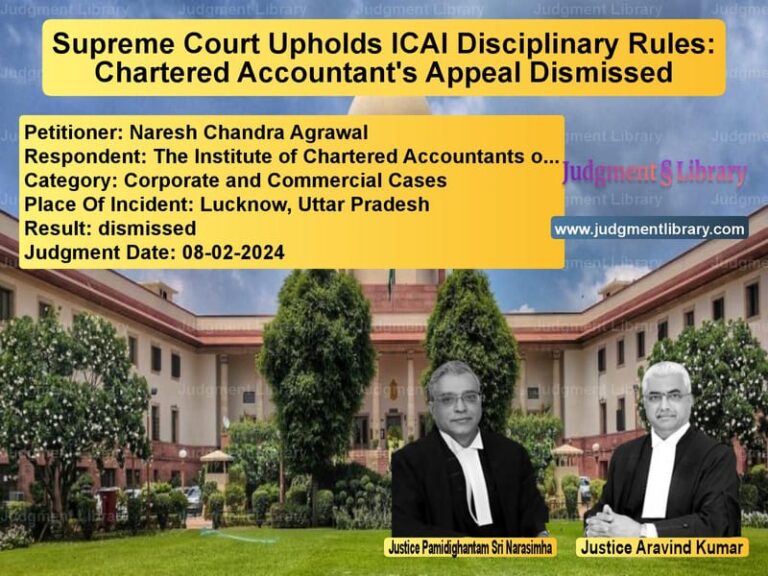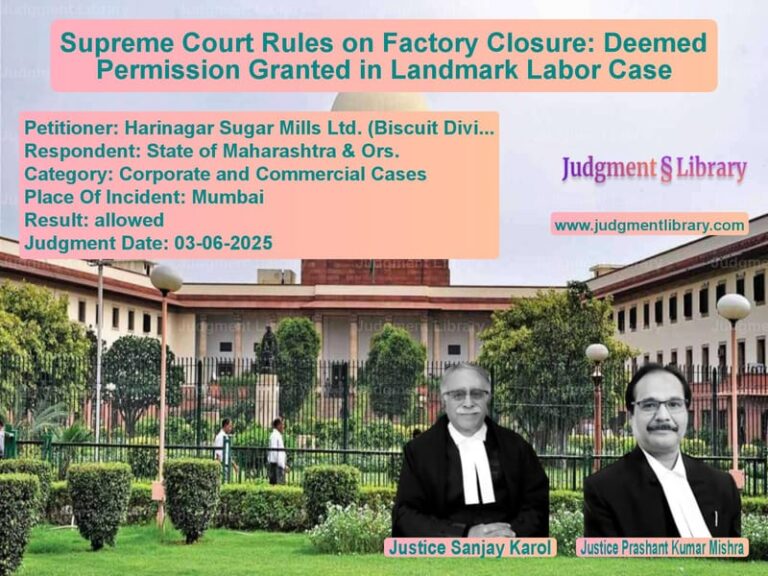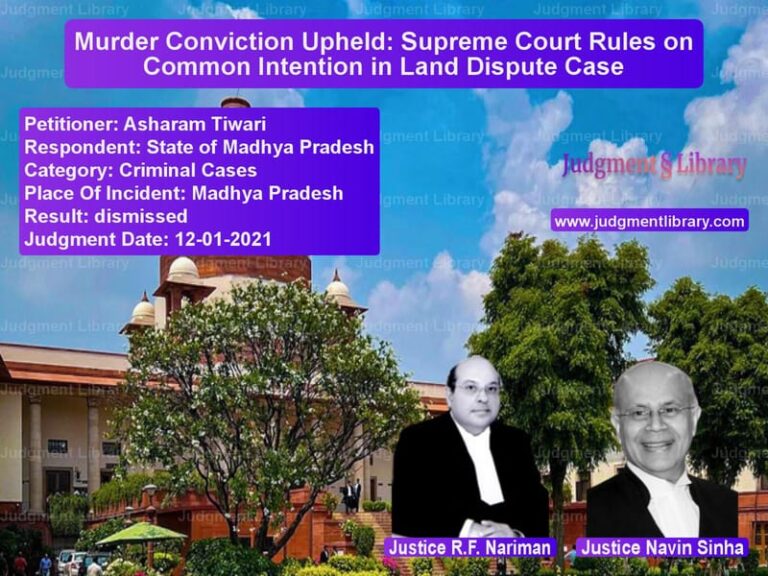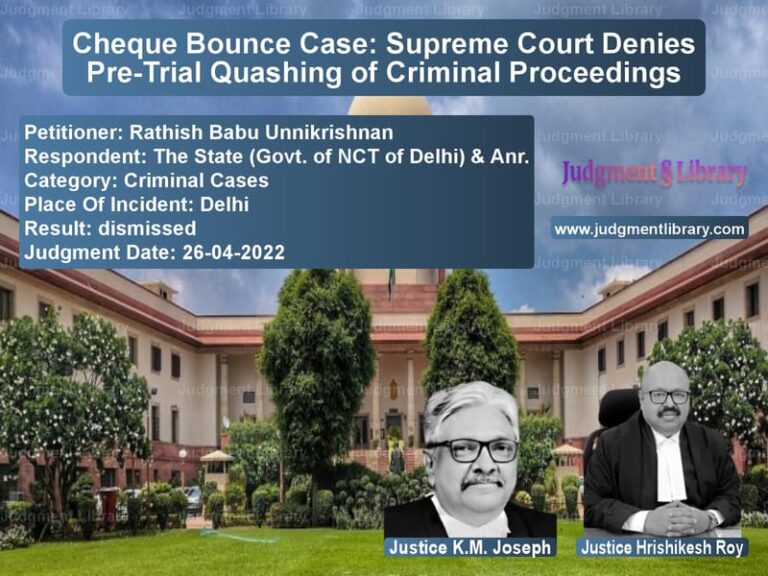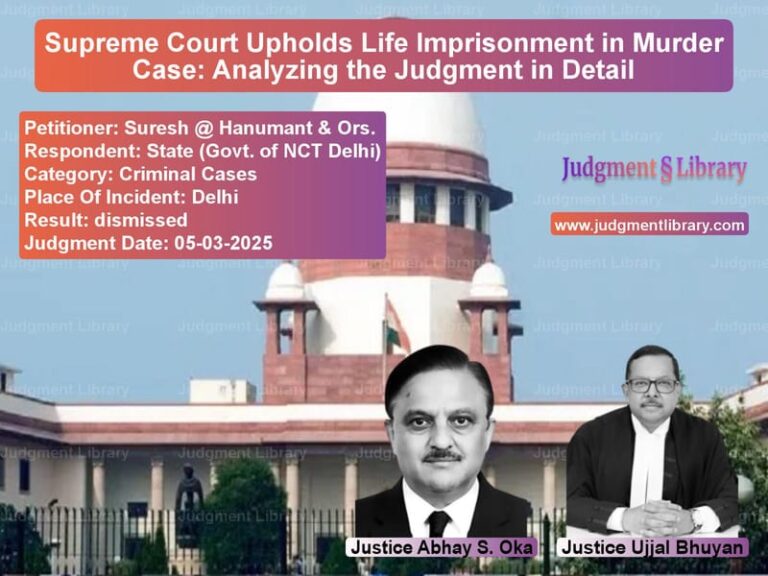SARFAESI Act: Supreme Court Allows Additional Magistrates to Exercise Powers for Asset Recovery
The case of M/s R.D. Jain and Co. vs. Capital First Ltd. & Others revolved around the interpretation of Section 14 of the Securitisation and Reconstruction of Financial Assets and Enforcement of Security Interest Act, 2002 (SARFAESI Act). The Supreme Court, in its judgment delivered by M.R. Shah and B.V. Nagarathna, upheld the Bombay High Court’s decision, ruling that Additional District Magistrates and Additional Chief Metropolitan Magistrates could exercise powers under Section 14 of the SARFAESI Act.
The primary issue was whether the terms “District Magistrate” and “Chief Metropolitan Magistrate” as mentioned in Section 14 could include Additional District Magistrates and Additional Chief Metropolitan Magistrates.
Background of the Case
The dispute arose when Capital First Limited, a financial institution and secured creditor, initiated recovery proceedings under the SARFAESI Act for loan defaults by M/s R.D. Jain and Co. The sequence of events was as follows:
- The secured creditor initiated action under Section 13(4) of the SARFAESI Act and took symbolic possession of the secured asset on 21 January 2017.
- The borrower refused to hand over physical possession of the asset.
- On 17 March 2017, the secured creditor filed an application under Section 14 before the Chief Metropolitan Magistrate (CMM), Mumbai, seeking assistance in taking possession of the property.
- The application remained pending for an extended period due to backlog, prompting the creditor to seek an expedited hearing.
- The High Court of Bombay, in response to a petition filed by the creditor, ruled that the Additional District Magistrate and Additional Chief Metropolitan Magistrate were empowered to act under Section 14.
- The borrower challenged this ruling before the Supreme Court.
Petitioner’s Arguments
The borrower, M/s R.D. Jain and Co., argued that:
- The SARFAESI Act specifically mentions “District Magistrate” and “Chief Metropolitan Magistrate” and does not include their Additional counterparts.
- The Gujarat, Kerala, and Calcutta High Courts had previously ruled that only the designated District Magistrates and Chief Metropolitan Magistrates could exercise these powers.
- Interpreting the Act otherwise would amount to judicial legislation.
- The Bombay High Court’s ruling was contrary to past Supreme Court judgments in Hari Chand Aggarwal vs. Batala Engineering Co. and Shivam Water Treaters P. Ltd. vs. State Bank of India.
Respondents’ Arguments
Capital First Limited and the State of Maharashtra argued that:
- Considering the heavy workload of District Magistrates and Chief Metropolitan Magistrates, delegating powers to Additional Magistrates was essential for efficient implementation of the SARFAESI Act.
- The SARFAESI Act provides for time-bound disposal of applications, and requiring only District Magistrates to handle these matters would result in significant delays.
- Under the Criminal Procedure Code (CrPC), Additional Chief Metropolitan Magistrates and Additional District Magistrates exercise similar powers as their counterparts.
- The High Court’s interpretation was necessary to ensure the timely enforcement of secured creditors’ rights.
Supreme Court’s Judgment
The Supreme Court analyzed the legislative intent behind the SARFAESI Act and the role of District Magistrates and Chief Metropolitan Magistrates. The key findings were:
1. SARFAESI Act’s Objective
The Court reaffirmed that the Act aims to expedite the recovery of non-performing assets and that delays in asset recovery defeat its purpose. The Court noted:
“The powers under Section 14 of the SARFAESI Act are ministerial in nature. There is no adjudicatory or quasi-judicial function involved. The provision is meant to assist secured creditors in taking possession of secured assets.”
Read also: https://judgmentlibrary.com/supreme-court-clarifies-limitation-period-for-initiating-cirp-under-ibc/
2. Additional Magistrates Have Equal Authority
The Court held that Additional Chief Metropolitan Magistrates and Additional District Magistrates, as defined under the CrPC, are functionally at par with Chief Metropolitan Magistrates and District Magistrates. It observed:
“The judicial powers of the Chief Metropolitan Magistrate and the Additional Chief Metropolitan Magistrate are identical. There is no reason to exclude Additional Magistrates from exercising powers under Section 14.”
3. Workload and Efficiency Considerations
The Court took judicial notice of the high number of pending cases under Section 14 of the SARFAESI Act and stated:
“If the interpretation of the borrower is accepted, it will be practically impossible for the District Magistrates and Chief Metropolitan Magistrates to dispose of applications within the statutory limit of 60 days.”
4. Overruling Contrary High Court Judgments
The Court overruled conflicting judgments from the Gujarat, Kerala, and Calcutta High Courts that had held that only designated District Magistrates could exercise power under Section 14. It stated:
“The view taken by the Bombay High Court is the correct interpretation of the law. The decisions of the Gujarat, Kerala, and Calcutta High Courts holding otherwise are not good law.”
Supreme Court’s Ruling
The Court ruled:
- The Bombay High Court’s interpretation of Section 14 of the SARFAESI Act was correct.
- Additional Chief Metropolitan Magistrates and Additional District Magistrates could exercise powers under Section 14.
- The borrower’s appeal was dismissed.
Conclusion
This judgment is a significant ruling in favor of financial institutions seeking to expedite asset recovery under the SARFAESI Act. By allowing Additional Magistrates to exercise powers under Section 14, the Court has streamlined the implementation of the Act and reduced delays in taking possession of secured assets.
The ruling reinforces the principle that procedural hurdles should not hinder the enforcement of legal rights, particularly in matters of financial recovery. This decision will serve as a precedent for future cases involving asset possession proceedings under the SARFAESI Act.
Petitioner Name: M/s R.D. Jain and Co..Respondent Name: Capital First Ltd. & Others.Judgment By: Justice M.R. Shah, Justice B.V. Nagarathna.Place Of Incident: Mumbai, Maharashtra.Judgment Date: 27-07-2022.
Don’t miss out on the full details! Download the complete judgment in PDF format below and gain valuable insights instantly!
Download Judgment: ms-r.d.-jain-and-co-vs-capital-first-ltd.-&-supreme-court-of-india-judgment-dated-27-07-2022.pdf
Directly Download Judgment: Directly download this Judgment
See all petitions in Bankruptcy and Insolvency
See all petitions in Contract Disputes
See all petitions in Corporate Compliance
See all petitions in unfair trade practices
See all petitions in Judgment by Mukeshkumar Rasikbhai Shah
See all petitions in Judgment by B.V. Nagarathna
See all petitions in dismissed
See all petitions in supreme court of India judgments July 2022
See all petitions in 2022 judgments
See all posts in Corporate and Commercial Cases Category
See all allowed petitions in Corporate and Commercial Cases Category
See all Dismissed petitions in Corporate and Commercial Cases Category
See all partially allowed petitions in Corporate and Commercial Cases Category

